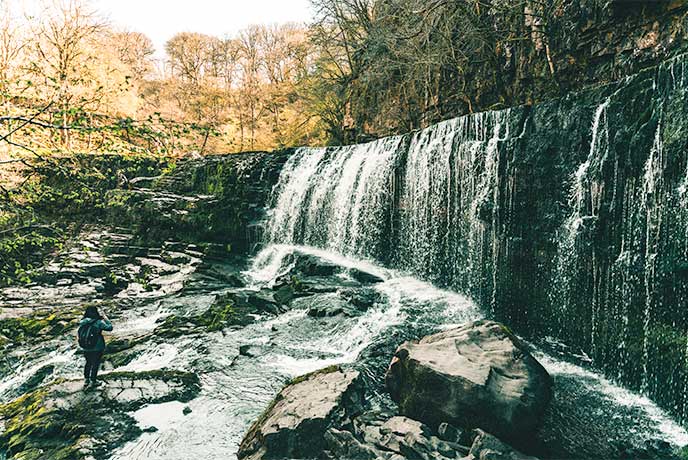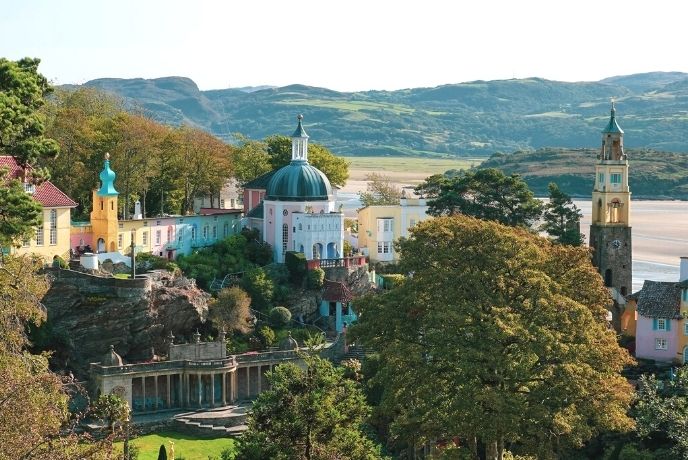Gwynedd’s beautiful stretch of coastline wasn’t always as tranquil as it is today. Hundreds of years ago, during the reign of Edward I, it was a major line of defence against invaders, which led to an impressive collection of fortified castles being built by architect James of St George; Caernarfon, Harlech, Conwy and Beaumaris.
Today, these dramatic castles form a World Heritage Site and still crown the coastline, offering a unique opportunity to delve into the past. Alongside these four giants lie smaller, but no less fascinating, castles, from Welsh strongholds to 19th-century neo-Norman family homes. Fairytale castles filled with dashing princes and hapless damsels, these are not – instead, these monster fortresses offer an intriguing glimpse into a history rich in political turmoil, ingenuity, and battle.
Want to scrub up on your history? Time to polish your family coat of arms and explore the many castles of Gwynedd…
Caernarfon Castle
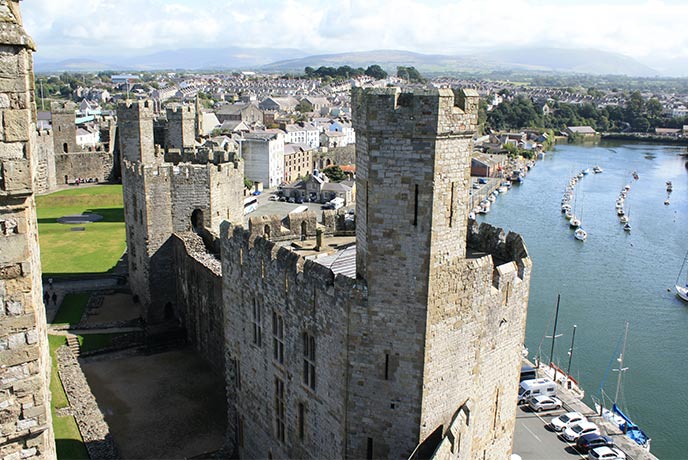
Castle Ditch, Caernarfon LL55 2AY
The huge fortress of Caernarfon Castle lies above the bank of the River Seiont and was built during the conflict with neighbouring Welsh princes, taking 47 years to complete and costing a massive £25,000 to build. Considered to be one of the greatest buildings of the Middle Ages and borrowing inspiration from the walls of Constantinople and Roman design, its massive curtain walls (a whopping 18 feet thick), King’s Gate, and three imposing turrets are brutishly magnificent and would have been extremely daunting for any invaders.
During the building of the castle in 1284, Edward I’s son was born amongst the building work and became the very first English Prince of Wales, beginning a legacy that every firstborn son of the reigning monarch is bestowed the title until crowned King. The Royal Welsh Fusiliers Museum is located within the castle and is well worth visiting, plus there’s a café and gift shop too. There are lots of family-friendly events that take place throughout the summer months, so it’s great for little ones too. After your visit, head out and explore the narrow streets and redeveloped waterfront of Caernarfon, or find the remains of Segontium, a Roman fort built some 1,000 years before the castle.
Harlech Castle

Castle Square, Harlech LL46 2YH
Crowning a mass of craggy rocks and overlooking the dunes, Harlech Castle boasts a most dramatic setting, with the majestic distant peaks of Snowdonia as its backdrop. Built in just seven years between 1282 and 1289 by Edward I and his military architect Master James of Saint George, it’s one of his most simply designed yet clever castles. Its unique ‘walls within walls’ design made invasion difficult, while the path made up of 108 steep steps up the outer walls meant that supplies could be delivered secretly when the castle was under siege.
However, the castle fell to the Welsh in 1404 and became the stronghold for the charismatic Owain Glyndŵr, who was crowned Prince of Wales within the castle. It was eventually reclaimed by Harry of Monmouth (later Henry V) in 1409. It’s interesting to note that the castle endured a seven-year siege during the War of the Roses, the longest siege in British history. Today, it’s much easier to access and leave the castle via the incredible floating footbridge! After you’ve visited the castle, spend some time discovering the pretty town of Harlech with its wide range of places to eat, independent shops to delve into, and coastal footpaths, perfect for an afternoon stroll. If you’re feeling extra active, you can attempt to climb Ffordd Pen Llech, the steepest street in the Northern Hemisphere!
Conwy Castle
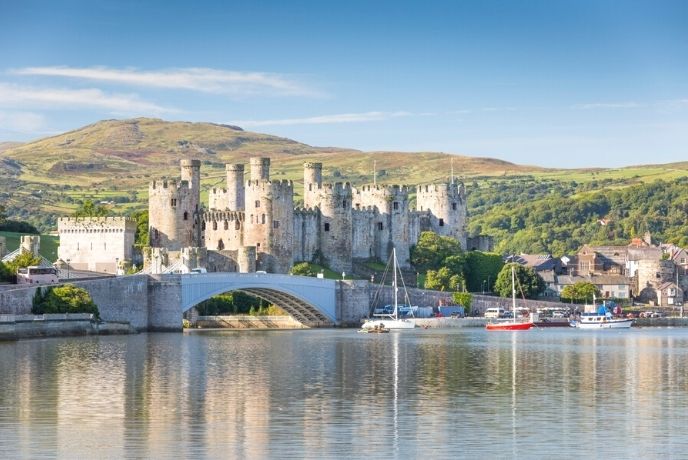
Rose Hill Street, Conwy LL32 8AY
Built in just four years between 1283 and 1287 by Edward I, Conwy Castle is an incredible feat of the medieval period that still stands proudly after 700 years - placing it high on Gwynedd’s to-do list. Exceptionally well preserved and set within eight ginormous towers and high curtain walls, you’ll discover the most intact medieval royal apartments in Wales and England, surpassing even the Tower of London. Make your way through the passages and discover such rooms as the Great Chamber and the beautiful chapel, where a ‘watching chamber’ enabled royalty to observe religious services in private (complete with its own toilet!).
Despite spending thousands of pounds on Conwy, Edward I only spent one miserable Christmas here (being trapped by a Welsh rebellion) and his queen Eleanor of Castile only ever saw it as a building site. In fact, the chambers were only ever used twice after that – once by the future Edward II, and once by Richard II. Other places of note include the Great Hall, whose magnificent interior is still intact. Thanks to a restoration project, you can climb the spiral staircases within the towers and walk a complete circuit around the battlements for incredible views over Snowdonia, down into the town of Conwy itself, and out towards the harbour. Once you’ve explored the castle, a walk along the three-quarter-mile ring of town walls is a must. Protected by 21 towers and three gateways, they still protect the original town – a stunning testament to the ingenuity of the builders who created it some 700 years ago.
Beaumaris Castle

Castle Street, Beaumaris LL58 8AP
Located in the pretty town of Beaumaris on the Isle of Anglesey, Beaumaris Castle is the last of the defensive castles built by Edward I. With construction beginning in 1295, this huge and almost completely symmetrical edifice would have been even more magnificent, but due to a lack of funds and with troubles brewing in Scotland, it was left unfinished by the 1320s. Its incompleteness gives Beaumaris a distinctively squat appearance but it is no less beautiful for it, being surrounded by a moat and overlooking the Menai Strait and Anglesey.
With four rings of defences and an outer wall encompassing nearly four acres, it's one of the largest and most impressive castles in Wales, housing giant towers, an inner bailey and a great hall, which would have been the social centre of the castle, with large windows, high ceilings and a majestic fireplace. Visitors can walk along the fortified walls, climb its towers and delve back in time with the castle’s informative displays and exhibits. Afterwards, take a stroll into the charming seaside town of Beaumaris where you can explore the narrow streets with its independent shops and eateries, then take a stroll along the picturesque waterfront.
Penrhyn Castle, Bangor

Bangor LL57 4HT
Very different to the other castles of Gwynedd, this huge neo-Norman castle was built between 1820 and 1837 for the Pennant family using the proceeds of the north Wales slate industry and their sugar plantations in Jamaica. National Trust-owned, as you explore the Gothic stairways and opulent rooms of Penrhyn Castle, you can’t help but be overwhelmed by the display of wealth, from the gold-flecked library to the grand keep bedrooms with breathtaking views over the estate and into Snowdonia National Park. The vast Victorian kitchens are well worth a visit too.
As the challenging past of the family is addressed thoughtfully by the National Trust, you’ll get a glimpse into a hugely transitional period of British history – making it a truly fascinating visit. Outside, the extensive gardens are spectacular, complete with a flower-filled walled garden and a fantastical bog garden, while the expansive lawns are ideal for a picnic, with glorious views over Conwy Bay and Snowdonia. Explore the wider estate and you’ll uncover flower meadows (a haven for insects and birds), rich native woodland, the original drive to the castle (which once welcomed Queen Victoria), a ruined chapel, an adventure playground for little explorers, and the ‘Elysian Fields’, which offer astonishing views over the Menai Strait.
Criccieth Castle
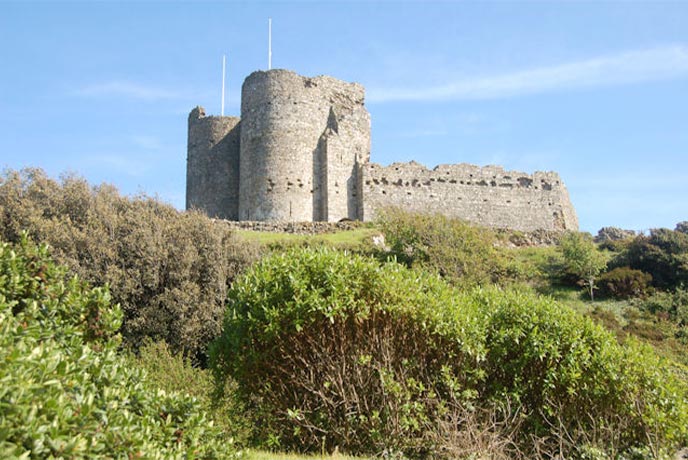
Criccieth LL52 0DP
Overlooking Cardigan Bay and situated on a rocky cliff set between two beaches, Criccieth Castle sits high above the surrounding seaside town, offering majestic views in every direction. Originally built by Llewelyn the Great (the prince of Gwynedd) in the English style, it was captured by Edward I in the late 13th century, some 50 years later. Even with its imposing twin-towered gatehouse, murder holes, and a stone-throwing machine, it didn’t stay in English hands too long – the Welsh hero Owain Glyndŵr reclaimed it and burnt it down after a long siege in the early 15th century, making it the last major Welsh rebellion against the English. With all this toing and froing, it’s not surprising that the castle was left in ruin!
Nevertheless, the beauty of this spot is simply breathtaking and has inspired many artists to capture it, such as J.M.W Turner, so let your imagination run wild as you walk around the ruins and gaze out to sea. Afterwards, spend some time on the beaches below or take a stroll along the promenade with an ice cream in hand.
Castell y Bere, Abergynolwyn
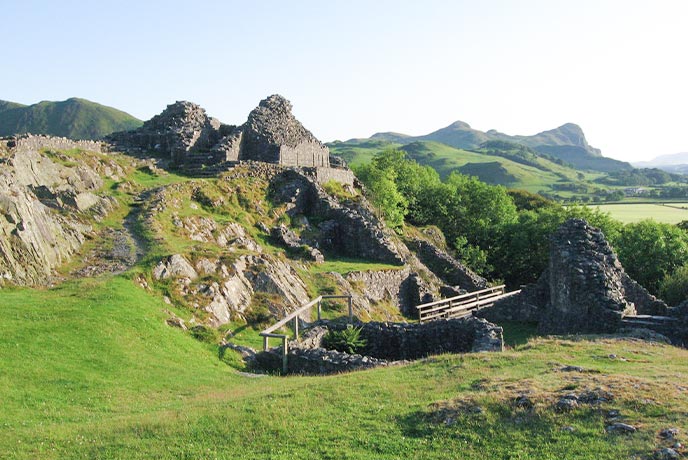
Abergynolwyn LL36 9TS
Clinging onto its rocky outcrop under the indomitable shadow of the mountains of Cader Idris and the Bird Rock plateau, Castell y Bere is a stunning and remote castle, built back in the early 13th century by Llewelyn the Great. Set adrift like an island on the floor of the Dysynni Valley, the castle ruins are an impressive sight on your approach, with its unusually elaborate entrance complete with a ditch and two gate towers, each with its own drawbridge and portcullis.
The castle was highly sophisticated for its time, probably as it was so important in protecting Llywelyn’s huge cattle ranch, the routeway from the coast in the north towards Dolgellau, and the southern border of Gwynedd. Despite the castle’s defences, Edward I invaded and took over the castle in 1283, hoping to make it into an English town, but just 11 years later the castle was abandoned during the Welsh uprising. While exploring this wild and beautiful spot, pay a visit to St Mary’s Church a short walk away. Built at the same time as the castle, look out for the leper’s window, which enabled the poor unfortunate people to join the service without entering the church. Pop in the car and head up the road for a walk to Dolgoch Falls, a beautiful spot with cascading waterfalls and a great café.
Excited to delve deeper into history? Take a look at our stunning holiday cottages in Gwynedd and Wales and start planning your tour of this fascinating and beautiful corner of Wales.


